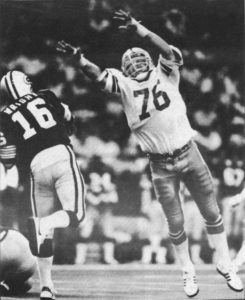The Misconception of Hospice Care
When the word hospice care comes up there is generally a negative connotation towards it. Its look as the junction between terminal illness and death. What they don’t know is that 17% of hospice patients are so-called live discharges, according to a report from the Medicare Payment Advisory Commission. For the other unfortunate part of this group they may have passed on but the last days of their life were lived to the fullest.

Bryan Caldwell playing for the Dallas Cowboys in 1983
Former NFL player, Bryan Caldwell was diagnosed with Hodgkin’s Lymphoma, a cancer of the immune system. He played for the Dallas Cowboys and Houston Oilers, but his career was cut short due to injuries. In January of 2013 he was told by doctors that he had six months to live and chose to stop chemotherapy. He returned to his daily life by making his home suitable for hospice care. Bryan was going to enjoy the last six months to fullest with his wife and children, knowing that any day he may die. He had a regular visit of a professional hospice nurse who gave him the care that one would get in a hospital. In addition, there was a hospice social worker which would help with his mental and emotional state in dealing with the terminal illness. He loved fishing for trout and black drum near his home in Palacios on the Texas Gulf Coast. Breakfast, lunch, and supper always had the entire family around the table allowing a close bond to form. Most importantly, he and his wife spent lots of time together having fun and giving each other support.
Bryan lived until his final day on January 3, 2015. He beat out the doctor’s date by more than a year and a half. With gods help and proper hospice care he got an unanticipated life extension that formed an everlasting bond with his family. Many patients miss this opportunity and accept their prognosis without considering hospice care.
Misunderstanding hospice care
One misconception of professional hospice is that it’s not where you go to die, but rather these professionals are trained to assist patients in living their lives fully, completely, and without pain until the end of their lives. Dr. Simin Beg a physician at Spectrum Health in Grand Rapids, MI said it best, “it’s about people concentrating on the quality of life and choosing to focus on the things which make them happy and comfortable”. At the same time the medical staff who attends the patient gets a wholesome view of their needs. Doctors will now focus on what are their spiritual or social needs and treat the patent and not just the disease. You won’t see this in a hospital setting where they attempt to get rid of the illness through extensive treatment which takes a toll on the body.
The challenge for a care giver is to know when the time is right for hospice care. One cannot anticipate getting the same medical treatment as they would receive in a hospital. When a patient can still receive healing the situation becomes complex. People that apply to hospice home in most cases are terminally ill who wish for a better quality of life. Its only when the patient is deemed critically ill are they then eligible for hospice care which can then be paid by Medicaid.

When should the discussion take place?
When all medical options are near to being exhausted its time for the care givers to sit down and have the conversation. Most importantly the family should seek information from hospice advisors to educate those attending the meeting. Here are some questions to ask to assess the need for hospice care.
- With all the excellent medical care that’s been administered have the patient’s symptoms and condition progressed to the point that it cannot be contained?
- Did a medical practitioner advise that there is nothing else to do for illness?
- After extensive treatment has the patient been exhausted and the side effects outweigh the benefits?
With the advance understanding in what terminally ill patients spiritual and emotional needs are more are getting discharged from hospice. According to government reports 1 in 5 hospice patients have been discharged before dying. This number has climbed steadily since 2000, peaking in 2012 and 2013.
Care givers should not think of hospice as giving up but rather it’s a unique opportunity to improve quality of life. If you or a family member needs help with finding a hospice care in Northeast Ohio get your hands on the Senior Comfort Guide. We list on our website hospice homes which have been verified to meet the highest standards here in Ohio. Please feel free to email us at info@seniorcomfortguide.com or call 216.292.8485 if you have any questions about hospice care.

I’ve been thinking about getting some hospice care for my grandmother, and I think that being able to get some help would be good. I’m glad you talked about being able to get some good hospice care being able to help form bonds. I think that being able to get some good hospice options and hopefully get some quality help! Thanks!
Jordan, I wish your grandmother the best of health in whatever assistance you choose. Checkout out our hospice options in Northeast Ohio .